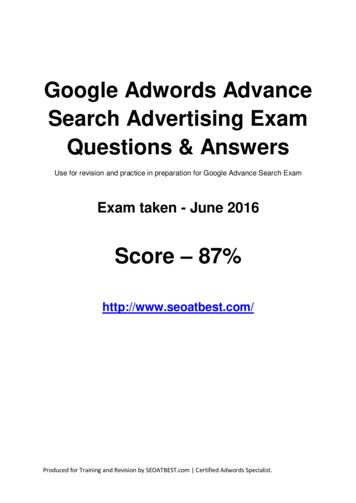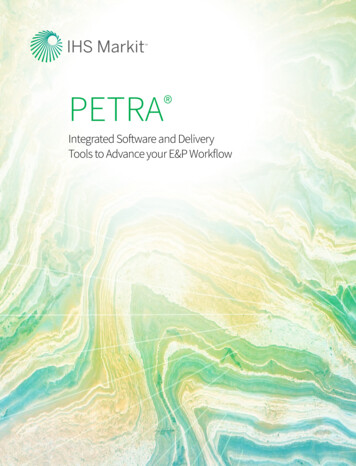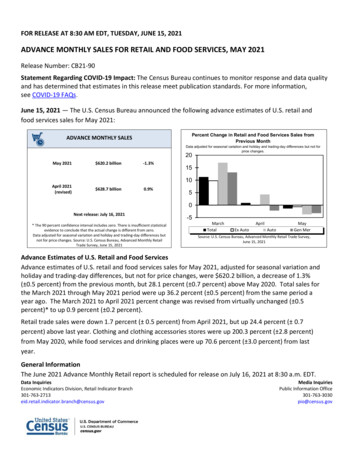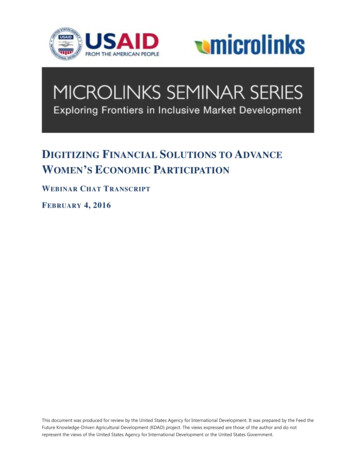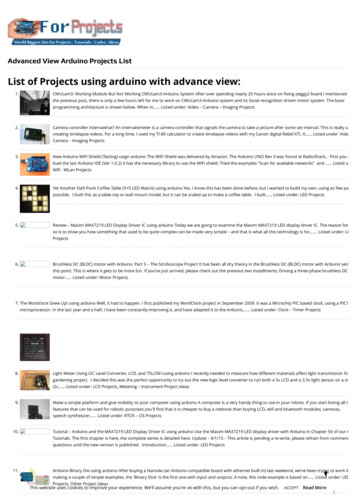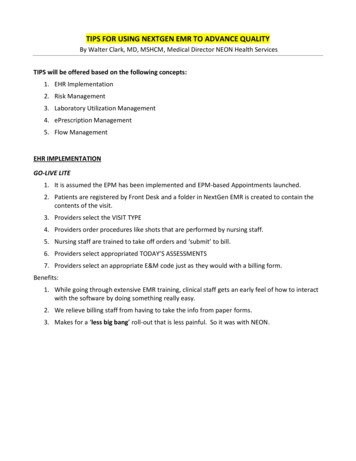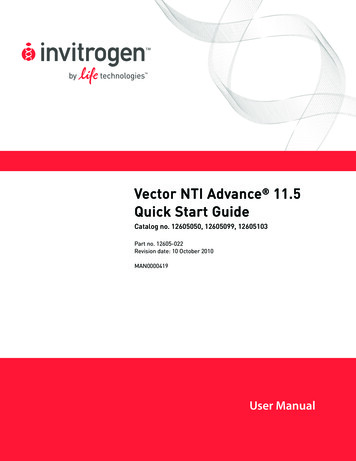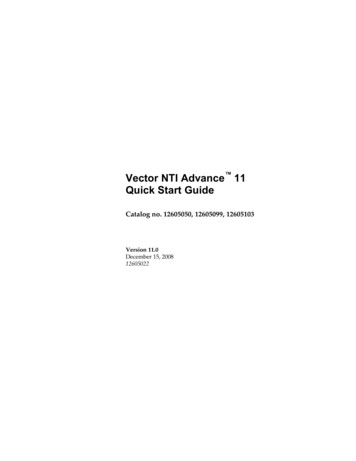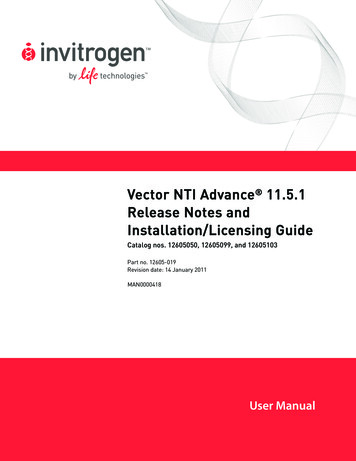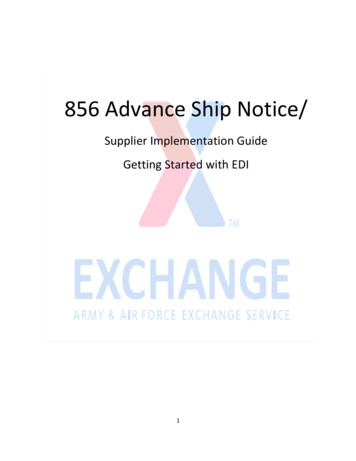
Transcription
Submitted to Operations Researchmanuscript (Please, provide the manuscript number!)Authors are encouraged to submit new papers to INFORMS journals by means ofa style file template, which includes the journal title. However, use of a templatedoes not certify that the paper has been accepted for publication in the named journal. INFORMS journal templates are for the exclusive purpose of submitting to anINFORMS journal and should not be used to distribute the papers in print or onlineor to submit the papers to another publication.Online Advance Admission Scheduling for Services,with Customer PreferencesXinshang Wang, Van-Anh TruongDepartment of Industrial Engineering and Operations Research, Columbia University, New York, NY, USA,xw2230@columbia.edu, vatruong@ieor.columbia.eduDavid Bank, MD, MBADepartment of Pediatrics, NYPH Morgan Stanley Children’s Hospital, Columbia University Medical Center, New York, NY,USA, deb40@columbia.eduWe study web and mobile applications that are used to schedule advance service, from medical appointmentsto restaurant reservations. We model these problems as online weighted bipartite matching problems withnon-stationary arrivals. We propose new algorithms with performance guarantees for this class of problems.Specifically, we show that the expected performance of our algorithms is bounded below by max( 12 , 1 q2 O( k1 )) times that of an optimal offline algorithm, which knows all future information upfront, whereπkk is the minimum capacity of a resource. This is the tightest known lower bound. Furthermore, we showthat12is the best constant relative performance that can be achieved. This performance analysis holds forany Poisson arrival process. Our algorithms can also be applied to a number of related problems, includingdisplay-ad allocation problems and revenue-management problems for opaque products. We test the empiricalperformance of our algorithms against several well-known heuristics by using appointment-scheduling datafrom a major academic hospital system in New York City. The results show that the algorithms exhibit thebest performance among all the tested policies. In particular, our algorithms are 21% more effective thanthe actual scheduling strategy used in the hospital system according to our performance metric.1. IntroductionWe study advance admission scheduling decisions in service systems. Advance admission schedulingdecisions are those that determine specific times for customers’ arrival to a facility for service.1
Author: Article Short TitleArticle submitted to Operations Research; manuscript no. (Please, provide the manuscript number!)2Advance admission scheduling is used in many service industries. Restaurants reserve tables forcustomers who call in advance. Healthcare facilities reserve appointment slots for patients whorequest them. Airlines reserve flight seats for those who purchase flight tickets. Advance admissionscheduling enables service providers to better match capacity with demand because they controlcustomers’ actual arrivals to service facilities.We formulate and analyze a model that generally captures such admission scheduling systems.For concreteness, we focus on the example of MyChart, a digital admission-scheduling applicationdeveloped by Epic System. Epic is an electronic medical records company that is managing therecords of millions of health care providers and more than half of the patient population in the U.S.(Husain 2014). Epic deploys MyChart to perform online scheduling of appointments through internet portals. The use of applications like MyChart is part of a general trend in healthcare towardsproviding electronic access to service through web and mobile applications (TechnologyAdvice2015).When a patient schedules an appointment over a web portal, MyChart first asks the patient forthe type of visit desired, whether it is for a physical exam, a consultation, a flu shot, etc. Next,it asks for the beginning and end of the range of preferred dates. It then shows a menu with acheck box for morning and afternoon session for each day in the preferred date range. Patientscan select one or more preferred sessions. Finally, MyChart either offers the patient one or moreappointments, or states that no appointment can be found. We can conceive of many variationsover this basic interface.Consider the following model of advance admission scheduling that captures MyChart as anexample. Consider a continuous time, finite horizon. There are multiple service providers. Eachprovider offers a number of service sessions over the horizon, some in regular hours and some inovertime. We call a session associated with a single provider a resource. There are n resourcesavailable over the horizon. All the resources are known. Each resource j can serve Cj customers.We call Cj the capacity of resource j. Each resource j must be booked by time tj or it perishes
Author: Article Short TitleArticle submitted to Operations Research; manuscript no. (Please, provide the manuscript number!)3at time tj . There are m customer types. Patients of type i, i 1, . . . , m, arrive according to someknown non-homogeneous Poisson process and make reservations through any of the modes madeavailable by the provider, web, phone, or mobile. A patient of type i generates a benefit of rij whenserved with a unit of resource j. We assume that the type of customers can be observed at the timethat they arrive to make an appointment, through the pattern of preferences that they indicateand any data stored in the system on their profiles. We require that customers arriving at timet have weight 0 for all resources j that perish at time tj t. The number of customer types canbe kept finite by discretizing the horizon but this number can be very large. We will discuss thispoint shortly. When a customer arrives, a unit of an available resource must be assigned to her, orshe must be rejected. Each unit of a resource can be assigned to at most one customer. We allowno-shows and the practice of overbooking to compensate for the effect of no-shows. The objectiveof the problem is to allocate the resources to the customers to maximize the expected total benefitof the allocation.Our advance-reservation model is essentially an online weighted bipartite matching problem.The resources in our model, when partitioned into units, can be seen as nodes on one side of abipartite graph. All the customers correspond to nodes on the other side that are arriving online.The type of each arriving customer is determined by a time-varying distribution.This resource-allocation model can be found in many other applications. We summarize threesuch applications below.Ad allocation. In a typical display-ad allocation problem, e-commerce companies aim at tailoringdisplay ads for each type of customers. Each ad, which corresponds to a unit of a resource, is oftenassociated with a maximum number of times to be displayed. Knowing the arrival rates of futurecustomers, the task is to make the most effective matching between ads and customers.Single-leg revenue management. Our model can be reduced to the classic single-leg revenuemanagement problem in which all resources to be allocated are available at the same time. Customers who bring a higher benefit correspond to higher-fare classes. The decision is how to admit
Author: Article Short TitleArticle submitted to Operations Research; manuscript no. (Please, provide the manuscript number!)4or reject customers, given the time remaining until the flight and the current inventory of availableseats.Management of opaque products. Internet retailers such as Hotwire or Priceline often offer abuyer an under-specified or opaque product, such as a flight ticket, with certain details such as theexact flight timing or the name of the airline withheld until after purchase. This enables the retailerto more flexibly manage their inventory. Opaque products are often sold at a discount comparedto specific products, making them attractive to wider segments of the market. These productsare common in internet advertising, tour operations, property management (Gallego et al. 2004)and e-retailing. Customers purchase an opaque product if the declared characteristics fit theirpreferences. The buyer agrees to accept any specific product that meets the opaque description.In our model, a specific product corresponds to a node on the right side of a bipartite graph. Aunit of demand for an opaque product corresponds to a node on the left that connects to all ofthe specific products contained in the opaque product. The weight of an edge corresponds to therevenue earned by selling the opaque product. Demands arrive randomly over time. We assumethat demand for each opaque product is exogenous and independent of the availability of otherproducts. This follows the traditional assumption of independent demand for revenue-managementproblems. When demand occurs, a decision is made to assign a specific product to that demandunit. Knowing the arrival rates of all demands, we want to maximize the total expected revenueby strategically assigning specific products.Our contributions in this work are as follows: We provide the first general, high-fidelity model of advance admission scheduling that capturescustomer preferences across different resources. We allow non-stationary arrivals and no-shows.We model the advance admission-scheduling problem as an online weighted bipartite matchingproblem with non-stationary arrivals. For this abstract online matching model with non-stationaryarrivals, we propose new algorithms with guarantees on the relative performance. We also provethe tightest known performance bound. Specifically, we show that the expected performance of
Author: Article Short TitleArticle submitted to Operations Research; manuscript no. (Please, provide the manuscript number!)our algorithms is bounded by approximately max( 21 , 1 q2 1π k5 O( k1 )) times that of an optimaloffline algorithm, which knows all future information upfront, where k is the minimum capacityof a resource. Furthermore, we show that12is the best constant relative performance that can beachieved. This performance analysis holds for any Poisson arrival process.Our algorithms work by solving a large-scale LP once, splitting the arrival process based onan optimal solution to the LP, and estimating a dynamic benefit function for each split arrivalprocess. The benefit function approximates the actual future benefit of a resource at any giventime, given its (split) arrival stream. The value of the benefit function decreases in time, capturingthe expiration of resources. When a customer arrives, our algorithm assigns a unit of resource thatmaximizes the positive part of the difference between the customer’s benefit and the estimatedmarginal benefit of the unit. Our model also has application in other important problems such as display-ad allocation andopaque revenue management. For the display-ad allocation problem, we give the tightest knownperformance bound for an algorithm, assuming non-stationary arrivals and arbitrary mean demand.For the opaque revenue-management problem, we are the first to study online allocation policiesfor model with an arbitrary number of products and time-varying arrival rates. We test the empirical performance of our algorithm against several well-known heuristics byusing appointment-scheduling data from a department within a major academic hospital system inNew York City. The results show that our scheduling algorithms perform the best among all testedpolicies. In particular, our algorithm is 21% more effective than the actual scheduling strategy usedin the hospital system according to our performance metric.2. Literature Review2.1. Appointment SchedulingOur work is related to the literature on appointment scheduling. This area has been studied intensively in recent years (Guerriero and Guido 2011, May et al. 2011, Cardoen et al. 2010, Gupta 2007).A large part of this literature considers intra-day scheduling, in which the number of patients to be
6Author: Article Short TitleArticle submitted to Operations Research; manuscript no. (Please, provide the manuscript number!)treated on each day is given or is exogenous, and the task is to determine an efficient sequence ofstart times for their appointments. Another part of the literature considers multi-day scheduling, inwhich patients are dynamically allocated to appointment days. Some works in this literature focuson the number of patients to be served today, with the rest of the patients remaining on a waitlistuntil the next day. This paradigm is called allocation scheduling. See, for example, Huh, Liu, andTruong (2013), Min and Yih (2010), Ayvaz and Huh (2010), Gerchak, Gupta and Henig (1996).Recently, more works have focused on the problem of directly scheduling patients into future days.This paradigm is called advance scheduling. This paper considers an advance scheduling modelwith multiple patient classes. In the literature of advance scheduling, Truong (2014) first studiesthe analytical properties of a two-class advance scheduling model and gives efficient solutions to anoptimal scheduling policy. For the multi-class model, no analytical result is known so far. Gocgunand Ghate (2012) and Patrick, Putterman, and Queyranne (2008) propose heuristics based onapproximate dynamic programming for these problem, but have not characterized the worst-caseperformance of these heuristics. We propose the first online scheduling policy with performanceguarantees for a very general multi-class advance-scheduling problem.Our advance-scheduling model captures the preferences of patients in a general way. Patientpreferences are an important consideration in most out-patient scheduling systems. In the literatureconsidering patient preferences, Gupta and Wang (2008) considers a single-day scheduling modelwhere each arriving patient picks a single slot with a particular physician, a
Department of Industrial Engineering and Operations Research, Columbia University, New York, NY, USA, xw2230@columbia.edu, vatruong@ieor.columbia.edu David Bank, MD, MBA Department of Pediatrics, NYPH Morgan Stanley Children’s Hospital, Columbia University Medical Center, New York, NY, USA, deb40@columbia.edu

